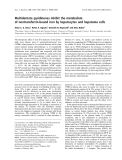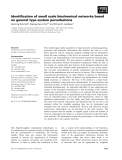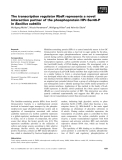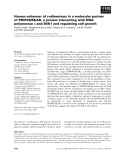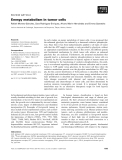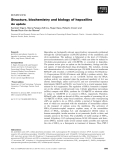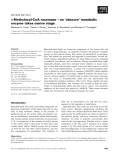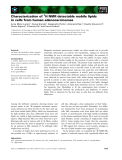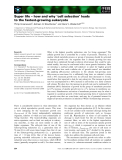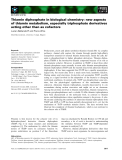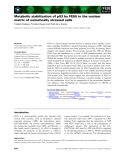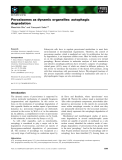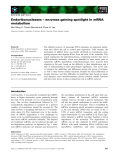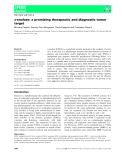
Cancer cell metabolism
-
Oncogenic metabolic reprogramming contributes to tumor growth and immune evasion. The intertumoral metabolic heterogeneity and interaction of distinct metabolic pathways may determine patient outcomes. In this study, we aim to determine the clinical and immunological significance of metabolic subtypes according to the expression levels of genes related to glycolysis and cholesterol-synthesis in bladder cancer (BCa).
 15p
15p  vielonmusk
vielonmusk
 21-01-2022
21-01-2022
 17
17
 0
0
 Download
Download
-
Lactic acid produced by tumors has been shown to overcome immune surveillance, by suppressing the activation and function of T cells in the tumor microenvironment. The strategies employed to impair tumor cell glycolysis could improve immunosurveillance and tumor growth regulation. Dichloroacetate (DCA) limits the tumorderived lactic acid by altering the cancer cell metabolism.
 12p
12p  vielonmusk
vielonmusk
 21-01-2022
21-01-2022
 7
7
 0
0
 Download
Download
-
Peroxisomes are pivotal metabolic organelles that exist in almost all eukaryote cells. A reduction in numbers and enzymatic activities of peroxisomes was found in colon adenocarcinomas. However, the role of peroxisomes or the peroxisome pathway in colorectal cancer (CRC) is not defined.
 17p
17p  vielonmusk
vielonmusk
 21-01-2022
21-01-2022
 12
12
 0
0
 Download
Download
-
Protein synthesis requires both amino acids, as precursors, and a substantial amount of metabolic energy. It is well established that starvation or lack of nutrients impairs pro-tein synthesis in mammalian cells and tissues. Branched chain amino acids are particularly effective in promoting protein synthesis. Recent work has revealed important new information about the mechanisms involved in these effects. Anumber of components of the translational machinery are regulated through signalling events that require the mam-malian target of rapamycin, mTOR. ...
 12p
12p  tumor12
tumor12
 22-04-2013
22-04-2013
 34
34
 2
2
 Download
Download
-
Anandamide is an endogenous ligand for cannabinoid receptor and its protein-mediated transport across cellular membranes has been demonstrated in cells derived from brain as well as in cells of the immune system. This lipid is inactivated via intracellular degradation by a fatty acid amidohydrolase (FAAH). In the present study, we report that rabbit platelets, in contrast to human platelets, do not possess a carrier-mediated mechanism for the transport of [ 3 H]anandamide into the cell, i.e. cellular uptake was not temperature dependent and its accumulation was not satu-rable. ...
 9p
9p  tumor12
tumor12
 20-04-2013
20-04-2013
 24
24
 3
3
 Download
Download
-
The therapeutic effect of iron (Fe) chelators on the poten-tially toxic plasma pool of nontransferrin-bound iron (NTBI), often present in Fe overload diseases and in some cancer patients during chemotherapy, is of considerable interest. In the present investigation, several multidentate pyridinones were synthesized and compared with their bidentateanalogue, deferiprone
 10p
10p  fptmusic
fptmusic
 16-04-2013
16-04-2013
 26
26
 2
2
 Download
Download
-
New technologies enable acquisition of large data-sets containing genomic, proteomic and metabolic information that describe the state of a cell. These data-sets call for systematic methods enabling relevant information about the inner workings of the cell to be extracted. One important issue at hand is the understanding of the functional interactions between genes, proteins and metabolites.
 11p
11p  awards
awards
 06-04-2013
06-04-2013
 26
26
 2
2
 Download
Download
-
Histidine-containing protein (HPr) is a central metabolic sensor in low-GC Gram-positive bacteria and plays a dual role in sugar uptake by the phos-phoenolpyruvate–sugar phosphotransferase system and in transcriptional control during carbon catabolite repression. The latter process is mediated by interaction between HPr and the carbon catabolite repression master transcription regulator, carbon catabolite protein A (CcpA), a member of the LacI-GalR family of DNA-binding proteins.
 11p
11p  inspiron33
inspiron33
 26-03-2013
26-03-2013
 48
48
 5
5
 Download
Download
-
Enhancer of rudimentary (ER) is a small protein that has a unique amino acid sequence and structure. Its highly conserved gene has been found in all eukaryotic kingdoms with the exception of fungi. ER was proposed to be involved in the metabolism of pyrimidines and was reported to act as a transcriptional repressor in a cell type-specific manner.
 14p
14p  inspiron33
inspiron33
 23-03-2013
23-03-2013
 49
49
 3
3
 Download
Download
-
In early studies on energy metabolism of tumor cells, it was proposed that the enhanced glycolysis was induced by a decreased oxidative phosphoryla-tion. Since then it has been indiscriminately applied to all types of tumor cells that the ATP supply is mainly or only provided by glycolysis, without an appropriate experimental evaluation.
 26p
26p  galaxyss3
galaxyss3
 21-03-2013
21-03-2013
 44
44
 4
4
 Download
Download
-
Hepoxilins are biologically relevant epoxy-hydroxy eicosanoids synthesized through the 12S-lipoxygenase (12S-LOX) pathway of the arachidonic acid (AA) metabolism. The pathway is bifurcated at the level of 12S-hydro-peroxy-eicosatetraenoic acid (12S-HpETE), which can either be reduced to 12S-hydro-eicosatetraenoic acid (12S-HETE) or converted to hepoxilins.
 10p
10p  galaxyss3
galaxyss3
 19-03-2013
19-03-2013
 21
21
 1
1
 Download
Download
-
Branched-chain lipids are important components of the human diet and are used as drug molecules, e.g. ibuprofen. Owing to the presence of methyl groups on their carbon chains, they cannot be metabolized in mitochon-dria, and instead are processed and degraded in peroxisomes. Several dif-ferent oxidative degradation pathways for these lipids are known, including a-oxidation, b-oxidation, and x-oxidation.
 14p
14p  media19
media19
 06-03-2013
06-03-2013
 39
39
 3
3
 Download
Download
-
Nur77 is one member of the nuclear receptor superfamily. As a transcrip-tion factor, Nur77 participates in a variety of biological processes, includ-ing T cell development, inflammatory responses, steroid hormone synthesis, and hepatic glucose metabolism. It typically acts via binding to the Nur77 responsive element (NBRE) in the promoter regions of its target genes.
 14p
14p  media19
media19
 06-03-2013
06-03-2013
 48
48
 4
4
 Download
Download
-
Magnetic resonance spectroscopy studies are often carried out to provide metabolic information on tumour cell metabolism, aiming for increased knowledge for use in anti-cancer treatments. Accordingly, the presence of intense lipid signals in tumour cells has been the subject of many studies aiming to obtain further insight on the reaction of cancer cells to external agents that eventually cause cell death.
 14p
14p  vinaphone15
vinaphone15
 27-02-2013
27-02-2013
 28
28
 3
3
 Download
Download
-
What is the highest possible replication rate for living organisms? The cellular growth rate is controlled by a variety of processes. Therefore, it is unclear which metabolic process or group of processes should be activated to increase growth rate. An organism that is already growing fast may already have optimized through evolution all processes that could be opti-mized readily, but may be confronted with a more generic limitation.
 17p
17p  vinaphone15
vinaphone15
 27-02-2013
27-02-2013
 30
30
 1
1
 Download
Download
-
Prokaryotes, yeasts and plants synthesize thiamin (vitamin B1) via complex pathways. Animal cells capture the vitamin through specific high-affinity transporters essential for internal thiamin homeostasis. Inside the cells, thi-amin is phosphorylated to higher phosphate derivatives. Thiamin diphos-phate (ThDP) is the best-known thiamin compound because of its role as an enzymatic cofactor.
 9p
9p  viettel02
viettel02
 22-02-2013
22-02-2013
 32
32
 3
3
 Download
Download
-
FE65 is a neural adaptor protein known to interact with a number of pro-teins, including Alzheimer’s amyloid b-protein precursor (APP). Although several different functions have been proposed for FE65, its primary physi-ological role remains unclear. We previously showed that APP can liberate FE65 from the membrane as a result of APP phosphorylation, and that the liberated FE65 translocates into the nuclei of osmotically stressed cells.
 11p
11p  viettel02
viettel02
 20-02-2013
20-02-2013
 35
35
 2
2
 Download
Download
-
Eukaryotic cells have to regulate peroxisomal metabolism to meet their environmental or developmental requirements. Therefore, the control of peroxisome number, which is mediated not only by proliferation but also by degradation, is an important cellular event. Here we briefly review stud-ies on the autophagic degradation of peroxisomes, a process now termed pexophagy.
 6p
6p  viettel02
viettel02
 19-02-2013
19-02-2013
 33
33
 3
3
 Download
Download
-
The efficient turnover of messenger RNA represents an important mecha-nism that allows the cell to control gene expression. Until recently, the mechanism of mRNA decay was mainly attributed to exonucleases, com-prising enzymes that degrade RNAs from the ends of the molecules.
 15p
15p  mobifone23
mobifone23
 18-01-2013
18-01-2013
 49
49
 5
5
 Download
Download
-
a-enolase (ENOA) is a metabolic enzyme involved in the synthesis of pyru-vate. It also acts as a plasminogen receptor and thus mediates activation of plasmin and extracellular matrix degradation. In tumor cells, EMOAis upregulated and supports anaerobic proliferation (Warburg effect), it is expressed at the cell surface, where it promotes cancer invasion
 0p
0p  cosis54
cosis54
 05-01-2013
05-01-2013
 44
44
 2
2
 Download
Download
CHỦ ĐỀ BẠN MUỐN TÌM








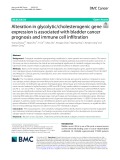


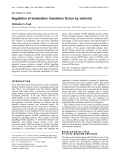
![Báo cáo khoa học: Uptake and metabolism of [3H]anandamide by rabbit platelets Lack of transporter? Báo cáo khoa học: Uptake and metabolism of [3H]anandamide by rabbit platelets Lack of transporter?](https://tailieu.vn/image/document/thumbnail/2013/20130420/tumor12/135x160/4891366448154.jpg)
